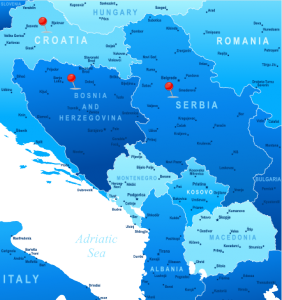Dragana Obradovic fled Bosnia with her mother and sister in 1994 during a savage regional conflict. Now, Obradovic is bringing students from those formerly warring nations together in the classroom to help them chart a path forward.
The associate professor of Slavic Languages and Literatures teaches Bosnian, Croatian and Serbian (BCS) as one language — an academically sound but controversial move that meant assembling teaching materials from scratch because no textbooks existed for such a course.
“While some grammar books have tried to grapple with two alphabets and language variation,” says Obradovic,“I had to develop my own teaching materials because nothing available was suitable for the particular language levels and experience of our students.”
The challenge went beyond developing a new range of teaching tools.
“When I put the languages together into one course, it was absolutely seen as a political statement by some,” says Obradovic, a 2018 Faculty of Arts & Science Outstanding Teaching Award winner.
I admire how her teaching represents everyone fairly and equally.
While keenly aware of the sensitivities, Obradovic reasoned that most of her students were born after the Balkan Wars, and her South Slavic program should reflect how the breakup of Yugoslavia has changed the regional dynamic.
“I admire how her teaching represents everyone fairly and equally,” says Burbuqe Cunaj, a third-year student in Slavic Studies who came to Toronto as a child with her Albanian family from Kosovo in 1999.
 “A lot of Kosovo Albanians struggle because they identified with Yugoslavia, and she has inspired me to teach Slavic courses and help them overcome that trauma.”
“A lot of Kosovo Albanians struggle because they identified with Yugoslavia, and she has inspired me to teach Slavic courses and help them overcome that trauma.”
Obradovic has worked to create a safe environment in her classes for students to examine the region’s history and debate what might come next, while forging their own identities separate from the allegiances carried here by their parents.
“A lot of my students swim in a soup of ambiguity and nothing that has happened since the war offers them an identity,” says Obradovic, who also teaches literature and history courses along with the language studies.
“When I was designing the curriculum, I thought this was an opportunity to broaden the perspectives and teach each side about the others.”
People in Bosnia, Croatia and Serbia view their languages as part of their national identities, and have little appetite for seeing them taught together, even though their small differences can, in some degree, be compared to British versus American English, says colleague Leonid Livak, a Russian literature professor.
She is not only a teacher but also an ambassador of a particular cultural attitude she is trying to convey to her students.
“She has to navigate a lot of landmines in her day-to-day life. She is not only a teacher but also an ambassador of a particular cultural attitude she is trying to convey to her students.”
Obradovic strives to deal with Slavic communities here and abroad in a respectful way. But while the war has officially ended, challenges to her inclusive teaching style remain.
Many families still have not located the remains of their loved ones. War crime tribunals only recently ended. Entire communities have disappeared and the regional map is far from settled.
“This is something that gets explored in my classes. It’s not just about the particular antagonisms people bring with them. The entire landscape of that region was destroyed in multiple ways and meanings,” says Obradovic.
I think a lot of anxiety and hatred stems from not really knowing.
“I constantly try to make the students think about the fact that nations are a very short-lived concept in the context of world history, so the curriculum is meant to challenge some of their assumptions and broaden what it means to study this part of the world.”
Olivera Bucalovic appreciates her approach.
“I think a lot of anxiety and hatred stems from not really knowing, and she helps dispel that by teaching everything so fully,” says Bucalovic, a fourth-year South Slavic Studies student whose family is from Serbia.
“And literally everyone I talk to says the language class is like therapy.”
People can identify with one group over another without going to extremes, adds Anthony Pehar, a second-year language studies student who is a member of the Croatian Students Association.
“We can fix things if we come together,” says Pehar, scoffing at the competing nationalist passions surrounding the BCS language debate. “Everything else is smoke and mirrors.”
For her part, Obradovic is optimistic about the direction of her scholarship and the path her students are taking.
“I sense they look at themselves in a transnational way because of the empathy they have for other Slavs, and that makes me hopeful for their future,” she says.
“And the next frontier for me is teaching the complexity of the modern state of affairs in that region.”

